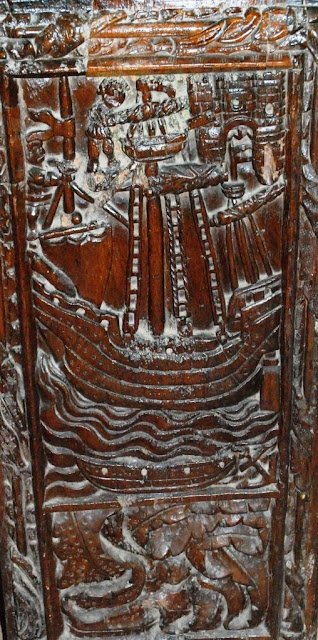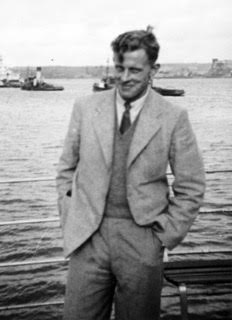AROUND THE TOWN AND OVER THE POND - 04: 'A DIVERSION TO RALEIGH’S BIRTHPLACE'
Continued from https://budleighpastandpresent.blogspot.com/2024/06/around-town-and-over-pond-03-of-bikes.html
AROUND THE TOWN AND OVER THE POND
A walk around Budleigh Salterton to interest transatlantic visitors. Every so often there’s a diversion which may inspire you to visit places like East Budleigh, Exeter, Sidmouth, Colyton or even places in the United States and Canada.
The walk is set out in parts. Here’s the fourth part:
Still at the Raleigh Wall.
0.4 A DIVERSION TO RALEIGH’S BIRTHPLACE
Historian Anna Beer poses next to 'The Boyhood of Raleigh' at Fairlynch Museum
To find the real Walter Raleigh is not easy. Not just because he was a controversial complex character – ‘a liar who believed his own lies’ – as historian Anna Beer writes, but because so many facts about his life are uncertain. We’re not even sure of the year of his birth, accepted as between 1552 and 1554.
Raleigh's birthplace, Hayes Barton. Image credit: Peter Bowler
At least we know that we will find him not on Budleigh beach
but at his family home in East Budleigh, at the farm known as Hayes Barton. That means taking the narrow Hayes Lane out of
the village for a few miles eastwards. I prefer approaching it on foot from
Budleigh Salterton through the woods to the south of Hayes Barton. Charming
though the building is, it’s not a castle or a manor house. It didn’t even belong to the Raleigh family.
The owner was local landowner Richard Duke, Lord of the Manor of Otterton.
This copy of Raleigh's letter is in Fairlynch Museum
We know that because Raleigh wrote to him in 1584 seeking to
buy Hayes Barton 'for naturall
disposition I have to that place being borne in that house'.
Vicars Mead, East Budleigh. Image credit: Peter Bowler
On the south side of Hayes Lane, as you enter the village
from Hayes Barton, is Vicars Mead, formerly known as Brooklands. It’s where
young Walter may have received his early schooling from the vicar, John Ford.
Again, no evidence for it.
Nor, coming from Hayes Lane to the Sir Walter Raleigh pub on the village’s High Street can you find any proof that the event shown on the pub sign actually took place.
It could well be yet another myth, like the ‘Boyhood’ painting. But if the cloak over the puddle act did take place, it may have been ‘not a spontaneous act of chivalry’ suggests British historical novelist Roger Norris, ‘but a premeditated act of political theatre, an advertisement of Raleigh’s ability to take his sovereign safely across the somewhat bigger puddle of the Atlantic Ocean to America’.
The building itself has been a pub only since the early 19th century when it was called The King’s Arms.
The statue of Raleigh in East Budleigh unveiled by the Duke of Kent in 2006
Further up the village street at the T-junction you find the statue of Raleigh by Vivien Mallock. It was unveiled on 7 February 2006 by the Duke of Kent who is standing in this photo with Steve Baker, chairman of East Budleigh Parish Council.
Controversial in death as in life, the figure stands with what Vivien Mallock hoped was ‘an air of arrogance and a whiff of mischief’ – apt words in view of the source of funding. Hugo Swire had persuaded British American Tobacco to bear the £30,000 cost of the statue, a move which upset the anti-smoking lobby.
And Raleigh’s shade may have been enjoying a private joke with me when I took this photo, hinting at how the great man met his end.
Myrtus communis. Image credit: Wikimedia
No bushes of myrtle have yet been planted around the statue, and yet it seems that Raleigh was responsible for importing the plant from Spain in 1585.
And outside the house on Hayes Lane where jars of jam and
marmalade are usually for sale I’ve looked in vain for a Raleigh brand. Again
it was Sir Walter with his interest in botany who is said to have introduced
the Seville or bitter orange from which marmalade is made.
Ah well! Perhaps a marmalade maker will be inspired by the
idea of a Sir Walter brand. And I wonder whether the Sir Walter Raleigh pub
serves rum. If so, it surely has to be this superb rum made in Guyana – a tribute
to Sir Walter and his quest for the mythical golden turrets and spires of Eldorado for which he is
celebrated. Scottish artist Ronnie Heeps depicted it in his 2004 painting ‘The
Quest for El Dorado’.
Back in 2018 when Budleigh Salterton’s Fairlynch Museum
marked the 400th anniversary of Sir Walter’ death, the pub was
serving this excellent Raleigh 400 ale but the brew is no longer available.
Sadly, Black Tor Brewery is no more.
You can’t possibly visit East Budleigh without spending time in the ancient and beautiful All Saints’ Church.
It has at least three connections with American history, including the 19th century English naval officer, Admiral George William Preedy CB, captain of HMS Agamemnon. He is commemorated in the church by this fine stained glass window.
You can find out more about him in Part 14 of AROUND THE TOWN AND OVER THE POND.
But it’s probably still the Raleigh connection from three centuries earlier which makes the All Saints Church most revered by American visitors. Raleigh’s father, also named Walter, was churchwarden here.
Seen above is the Raleigh family pew, the shield on the pew end having been defaced at some time in the past. It was here that the family worshipped.
However it is thought that young Walter may have been baptised at Place Court, pictured above, in the neighbouring village of Colaton Raleigh.
The Raleigh pew end is one of 63 carved oak masterpieces, one
of them dated 1537. Could this one depicting a ship have inspired young Walter
and Roger to cross the oceans?
Some people have claimed that this one represents a Native American, proof that sailors from East Budleigh had visited the New World. Others believe that it represents a Green Man or foliate head, namely a face surrounded by foliage to symbolise the cycle of new growth that occurs every spring.
Similarly controversial is this pew end. Clearly a man eating a banana – more evidence of distant voyages to tropical lands, say some. No, say others, pointing out that a swollen tongue could be seen as a traditional punishment for the sin of tale-bearing.
Questions like these intrigue all visitors to All Saints, including the youngest, especially when they have a guide like ‘Sir Walter Raleigh’ to show them round the church. Children from Brixington Primary Academy have visited the church on two occasions, the last being in March 2024.
Raleigh, left, as Captain of the
Guard at the funeral of Queen Elizabeth I. Image credit: British Library
Looking down on us in All Saints’ Church as we try to puzzle out the answers to some of these questions, including so many enigmas connected to his life, is a copy of a portrait of Sir Walter. The original dates from 1588, a year after Raleigh had been appointed Captain of the Guard in 1587.
The portrait itself asks a question, according to two American authors in a book on genealogical history published in 2012. Elizabeth Caldwell Hirschman and Donald N. Yates theorise that tin and copper mining in South West Britain along with its trading connections to North Africa and the Mediterranean may account for the higher than usual rate of genetic markers with links to that part of the world.
‘As can be seen in portraits, the Raleighs, Drakes and Gilberts were uniformly dark with prominent noses, high foreheads and narrow faces – not unlike Iberian and Moroccan Jews,’ they write in ‘Jews and Muslims in British Colonial America’.
A
depiction of Joachim Gans and Thomas Hariot, scientists employed by Raleigh, in
the workshop which they set up on Roanoke Island. In the 1990s, when
archaeologists uncovered the site of the mineral laboratory, they discovered
traces of copper from which silver was likely extracted. Image credit: National
Park Service https://www.nps.gov
They point out that the Bohemian mining expert and metallurgist Joachim Ganz was an Ashkenazi Jew who made multiple trips to North America in the employ of Sir Walter Raleigh.
Evidently he was protected by Raleigh in spite of his religious beliefs, for in 1589 he was arrested in the port city of Bristol as an infidel. During a preliminary hearing he admitted that he was a circumcised Jew who did not believe in the Christian religion, upon which he was taken to London for trial. However, probably because he was known to such important persons as Sir Walter Raleigh and Secretary of State Sir Francis Walsingham, no trial seems to have taken place.
This copy in All Saints’ Church of one of the best known portraits of Sir Walter was formerly attributed to Frederico Zuccaro (1542-1609) but is now attributed to the monogrammist 'H' (? Hubbard). It shows Raleigh in court dress at the height of his favour with Queen Elizabeth I. The original was acquired by the National Portrait Gallery in 1857
So, a final question. Was Sir Walter Raleigh Jewish?
Click on the link to continue in Part 5 at
https://budleighpastandpresent.blogspot.com/2024/06/around-town-and-over-pond-05-american.html


























Comments
Post a Comment